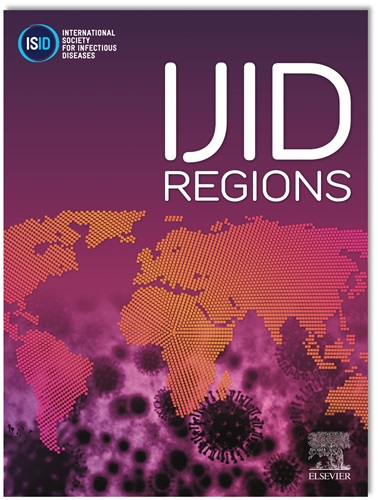Geospatial mapping of drug-resistant tuberculosis prevalence in Africa at national and sub-national levels
IF 4.8
2区 医学
Q1 INFECTIOUS DISEASES
引用次数: 0
Abstract
Objectives
To map subnational and local prevalence of drug-resistant tuberculosis (DR-TB) across Africa.
Methods
We assembled a geolocated dataset from 173 sources across 31 African countries, comprising drug susceptibility test results and covariate data from publicly available databases. We used Bayesian model-based geostatistical framework with multivariate Bayesian logistic regression model to estimate DR-TB prevalence at lower administrative levels.
Results
We estimated 148,239 DR-TB cases (95% uncertainty interval: 17,499-313,683) in Africa, showing significant variation by country. Eswatini and South Africa had highest case numbers, while Algeria and Egypt had the lowest. The highest DR-TB prevalence was estimated in Eswatini (53.26; 95% uncertainty interval 13.13-66.12), Morocco, Tunisia, and South Africa, while the lowest prevalence was found in Gabon, the Republic of Congo, Sierra Leone, and Mali. Marked subnational variation in DR-TB prevalence was noted, where 91 subnational areas across 12 countries had prevalence rates higher than their respective national averages. Factors such as mean temperature (β = 2.01; 95% CrI: 1.21, 3.42), population density (β = 0.41; 95% CrI: 0.19, 0.95), and fine particulate matter (β = 0.66; 95% CrI: 0.20, 0.80) were positively associated with DR-TB prevalence.
Conclusion
The study highlights substantial national and subnational variability in DR-TB prevalence across Africa, aiding policymakers in designing localized TB control interventions.
非洲国家和国家以下各级耐药结核病流行情况的地理空间制图。
目的:绘制非洲次国家和地方耐药结核病(DR-TB)流行情况。方法:我们从31个非洲国家的173个来源收集了一个地理数据集,包括药物敏感性测试结果和来自公开数据库的协变量数据。我们使用基于贝叶斯模型的地统计学框架和多元贝叶斯逻辑回归模型来估计较低行政级别的耐药结核病患病率。结果:我们在非洲估计了148,239例耐药结核病病例(95%不确定区间[UI]: 17,499- 313,683),显示出各国之间的显著差异。斯威士兰和南非的病例数最多,而阿尔及利亚和埃及的病例数最少。据估计,斯威士兰的耐药结核病患病率最高(53.26;95%(13.13-66.12)、摩洛哥、突尼斯和南非,而发病率最低的是加蓬、刚果共和国、塞拉利昂和马里。报告指出,耐药结核病流行率在国家以下地区存在显著差异,12个国家的91个国家以下地区的流行率高于各自的全国平均水平。平均温度(β=2.01;95% CrI: 1.21, 3.42),种群密度(β=0.41;95% CrI: 0.19, 0.95),细颗粒物(β=0.66;95% CrI: 0.20, 0.80)与耐药结核病患病率呈正相关。结论:该研究突出了非洲耐药结核病流行在国家和地方上的巨大差异,有助于决策者设计局部结核病控制干预措施。
本文章由计算机程序翻译,如有差异,请以英文原文为准。
求助全文
约1分钟内获得全文
求助全文
来源期刊
CiteScore
18.90
自引率
2.40%
发文量
1020
审稿时长
30 days
期刊介绍:
International Journal of Infectious Diseases (IJID)
Publisher: International Society for Infectious Diseases
Publication Frequency: Monthly
Type: Peer-reviewed, Open Access
Scope:
Publishes original clinical and laboratory-based research.
Reports clinical trials, reviews, and some case reports.
Focuses on epidemiology, clinical diagnosis, treatment, and control of infectious diseases.
Emphasizes diseases common in under-resourced countries.

 求助内容:
求助内容: 应助结果提醒方式:
应助结果提醒方式:


